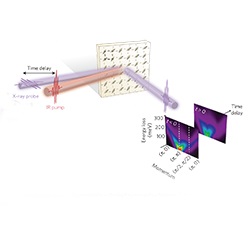09 May 2016
Understanding how magnets lose or change their orientation when excited is extremely challenging. This is because the electronic spins can rotate and propagate extremely quickly. In order to observe these effects, pictures need to be taken within a trillionth of a second with nanoscale resolution.
Now an international team of researchers from China, Germany, Japan, Spain, the UK and USA has been able to synchronize infrared and x-ray laser pulses and use them to simultaneously manipulate and reveal the ultra-fast magnetic properties of the compound at study, that is to reveal light-induced femtosecond magnetic dynamics. The study has been published in Nature Materials.
For their study, the team of researchers used a strontium-iridium-oxygen compound (Sr2IrO4), selected for its strong magnetic interactions. They first destroyed the native magnetic state of the material by having infrared laser pulses hit the layered Sr2IrO4 compound. The electrons inside the material formed spin waves that rippled through the material and radically changed its electronic and magnetic properties. Trillionths of a second later, an x-ray pulse followed and bounced off those emergent waves. By measuring the change in both momentum and the angles of diffraction, the scientists could deduce the transient electronic and magnetic qualities.
At ICFO, the Ultrafast Optical Dynamics of Solids research group led by ICFO Prof. Simon Wall contributed expertise in femtosecond laser excitation and analysis of transient dynamics. Dr. Wall comments “This was an extremely challenging, first-of-its-kind experiment which required the combination of state of the art X-ray, optical and accelerator technology and techniques. The results not only enable us to understand how magnetism works and can be manipulated in Sr2IrO4 better, but demonstrates a new technique that can now be applied to a whole range of superconducting and magnetic materials” .
The novel x-ray technique used in this study, known as time-resolved resonant inelastic scattering, revealed the dynamics of these subtle spin correlations, which travel as waves through the material and define its magnetic properties. The rapid switching between magnetic states, achieved with the use of light, could one day revolutionize the reading and writing of data in computers and other digital devices.

Watching nano-scale magnetic spin waves
An international team of researchers is able to reveal the dynamics of atomic spins using ultra-fast X-ray lasers.

Scattering setup to measure the time-dependent dynamics of spin waves













